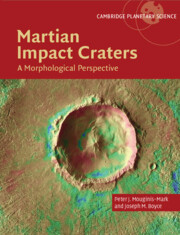Book contents
- Martian Impact Craters
- Cambridge Planetary Science
- Martian Impact Craters
- Copyright page
- Contents
- Preface
- Abbreviations
- 1 Impact Crater Formation
- 2 Morphology of Craters Throughout the Solar System
- 3 Knowing Mars
- 4 Fresh Crater Interiors
- 5 Modified Crater Interiors
- 6 Mars Crater Exterior Features – Major Types of Ejecta Blanket
- 7 Mars Crater Exterior Features – Other Ejecta Attributes
- 8 Ejecta Flow Features
- 9 Remaining Puzzles Concerning Martian Craters
- Appendix
- References
- Index
- References
References
Published online by Cambridge University Press: 09 October 2025
- Martian Impact Craters
- Cambridge Planetary Science
- Martian Impact Craters
- Copyright page
- Contents
- Preface
- Abbreviations
- 1 Impact Crater Formation
- 2 Morphology of Craters Throughout the Solar System
- 3 Knowing Mars
- 4 Fresh Crater Interiors
- 5 Modified Crater Interiors
- 6 Mars Crater Exterior Features – Major Types of Ejecta Blanket
- 7 Mars Crater Exterior Features – Other Ejecta Attributes
- 8 Ejecta Flow Features
- 9 Remaining Puzzles Concerning Martian Craters
- Appendix
- References
- Index
- References
Information
- Type
- Chapter
- Information
- Martian Impact CratersA Morphological Perspective, pp. 150 - 159Publisher: Cambridge University PressPrint publication year: 2025
References
Accessibility standard: Inaccessible, or known limited accessibility
Why this information is here
This section outlines the accessibility features of this content - including support for screen readers, full keyboard navigation and high-contrast display options. This may not be relevant for you.Accessibility Information
Content Navigation
Allows you to navigate directly to chapters, sections, or non‐text items through a linked table of contents, reducing the need for extensive scrolling.
Provides an interactive index, letting you go straight to where a term or subject appears in the text without manual searching.
Reading Order & Textual Equivalents
You will encounter all content (including footnotes, captions, etc.) in a clear, sequential flow, making it easier to follow with assistive tools like screen readers.
Structural and Technical Features
You gain clarity from ARIA (Accessible Rich Internet Applications) roles and attributes, as they help assistive technologies interpret how each part of the content functions.
